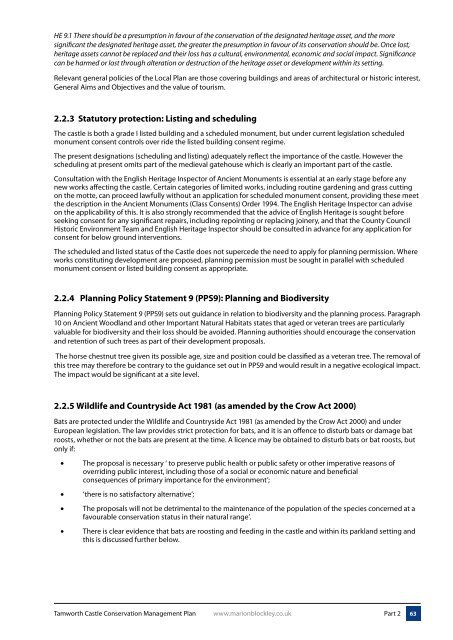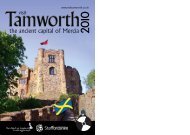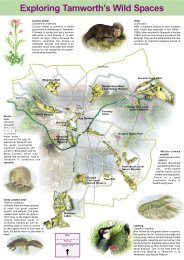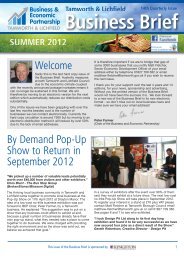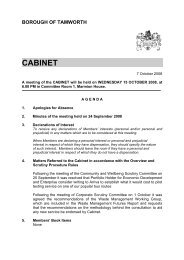Conservation Management Plan - Tamworth Borough Council
Conservation Management Plan - Tamworth Borough Council
Conservation Management Plan - Tamworth Borough Council
Create successful ePaper yourself
Turn your PDF publications into a flip-book with our unique Google optimized e-Paper software.
HE 9.1 There should be a presumption in favour of the conservation of the designated heritage asset, and the more<br />
significant the designated heritage asset, the greater the presumption in favour of its conservation should be. Once lost,<br />
heritage assets cannot be replaced and their loss has a cultural, environmental, economic and social impact. Significance<br />
can be harmed or lost through alteration or destruction of the heritage asset or development within its setting.<br />
Relevant general policies of the Local <strong>Plan</strong> are those covering buildings and areas of architectural or historic interest,<br />
General Aims and Objectives and the value of tourism.<br />
2.2.3 Statutory protection: Listing and scheduling<br />
The castle is both a grade I listed building and a scheduled monument, but under current legislation scheduled<br />
monument consent controls over ride the listed building consent regime.<br />
The present designations (scheduling and listing) adequately reflect the importance of the castle. However the<br />
scheduling at present omits part of the medieval gatehouse which is clearly an important part of the castle.<br />
Consultation with the English Heritage Inspector of Ancient Monuments is essential at an early stage before any<br />
new works affecting the castle. Certain categories of limited works, including routine gardening and grass cutting<br />
on the motte, can proceed lawfully without an application for scheduled monument consent, providing these meet<br />
the description in the Ancient Monuments (Class Consents) Order 1994. The English Heritage Inspector can advise<br />
on the applicability of this. It is also strongly recommended that the advice of English Heritage is sought before<br />
seeking consent for any significant repairs, including repointing or replacing joinery, and that the County <strong>Council</strong><br />
Historic Environment Team and English Heritage Inspector should be consulted in advance for any application for<br />
consent for below ground interventions.<br />
The scheduled and listed status of the Castle does not supercede the need to apply for planning permission. Where<br />
works constituting development are proposed, planning permission must be sought in parallel with scheduled<br />
monument consent or listed building consent as appropriate.<br />
2.2.4 <strong>Plan</strong>ning Policy Statement 9 (PPS9): <strong>Plan</strong>ning and Biodiversity<br />
<strong>Plan</strong>ning Policy Statement 9 (PPS9) sets out guidance in relation to biodiversity and the planning process. Paragraph<br />
10 on Ancient Woodland and other Important Natural Habitats states that aged or veteran trees are particularly<br />
valuable for biodiversity and their loss should be avoided. <strong>Plan</strong>ning authorities should encourage the conservation<br />
and retention of such trees as part of their development proposals.<br />
The horse chestnut tree given its possible age, size and position could be classified as a veteran tree. The removal of<br />
this tree may therefore be contrary to the guidance set out in PPS9 and would result in a negative ecological impact.<br />
The impact would be significant at a site level.<br />
2.2.5 Wildlife and Countryside Act 1981 (as amended by the Crow Act 2000)<br />
Bats are protected under the Wildlife and Countryside Act 1981 (as amended by the Crow Act 2000) and under<br />
European legislation. The law provides strict protection for bats, and it is an offence to disturb bats or damage bat<br />
roosts, whether or not the bats are present at the time. A licence may be obtained to disturb bats or bat roosts, but<br />
only if:<br />
• The proposal is necessary ‘ to preserve public health or public safety or other imperative reasons of<br />
overriding public interest, including those of a social or economic nature and beneficial<br />
consequences of primary importance for the environment’;<br />
• ‘there is no satisfactory alternative’;<br />
• The proposals will not be detrimental to the maintenance of the population of the species concerned at a<br />
favourable conservation status in their natural range’.<br />
• There is clear evidence that bats are roosting and feeding in the castle and within its parkland setting and<br />
this is discussed further below.<br />
<strong>Tamworth</strong> Castle <strong>Conservation</strong> <strong>Management</strong> <strong>Plan</strong> www.marionblockley.co.uk<br />
Part 2<br />
63


